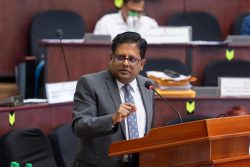The Government has published a contract of insurance for ExxonMobil Guyana Limited (EMGL) which will raise further questions about coverage for a potential oil spill and other matters.
The Official Gazette of May 11th 2024 made public the policy that ExxonMobil has with United Kingdom Insurance company Aon under policy number: ENOFC2400258 which is for the period February 1st of this year to February 19th 2025, and points out that the policy shall be governed by and construed in accordance with the laws of England & Wales.
The policy makes clear that the limit is “USD 100,000,000 (for) any one accident or occurrence in respect of third party liability” and “USD 500,000,000 any one accident or occurrence in respect of operators extra expense”.
It is unclear if this is an adjunct to a court-ordered US$2b guarantee from EMGL or the US$2b guarantee itself.
The insurance policy agreement can be accessed at the following link: (https://officialgazette.gov.gy/images/gazette2024/may/Extra_11MAY2024NotiContr.pdf)
The publishing of the contract comes amid an ongoing case where environmentalists and others have argued that ExxonMobil and its partners should be held to unlimited insurance coverage. This position was upheld by Justice Sandil Kissoon in a historic ruling which has since been appealed by Guyana’s Environmental Protection Agency.
In the decision on May 3rd 2023, Justice Kissoon had ordered the EPA to obtain from ExxonMobil’s subsidiary, environmental liability insurance as is customary in the petroleum industry along with an unlimited parent company guarantee to cover all costs of an oil spill, in accordance with the environmental permit issued to ExxonMobil Guyana Ltd.
Both the EPA and Exxon Guyana appealed the decision.
On June 8th, last year Justice of Appeal Rishi Persaud granted a stay of Justice Kissoon’s order, and ordered ExxonMobil’s subsidiary to produce a guarantee for US$2 billion within a fixed timeframe instead, and stayed the requirement for insurance.
The applicants in the matter Frederick Collins and Godfrey Whyte then applied to the court for proof that the US$2b had been lodged.
Justice of Appeal Persaud in February of this year said that he does not have jurisdiction to order ExxonMobil to provide proof that it has indeed lodged a US$2 billion guarantee which is intended to indemnify Guyana against an oil spill and associated perils.
The application for proof that ExxonMobil has indeed lodged the money has been met with resistance by the EPA and the oil company, which had both argued that the court lacked jurisdiction to make such an order.
It is unclear if there was a similar contract for insurance – as the one now published by the government – for the period of 2023 to 2024 as to date neither the EPA nor ExxonMobil has produced such.
Full coverage for any spill or accident in the Atlantic has been a years-long battle that began under the immediate past Head of the Environmental Protection Agency, Dr Vincent Adams. He was dismissed from his post by the PPP/C government after it took office in August of 2020.
In his ruling on May 3rd, 2023, Justice Kissoon said: “The EPA has relegated itself to a state of laxity of enforcement and condonation compounded by a lack of vigilance thereby putting this nation and its people in grave potential danger of calamitous disaster”.
He said that in the course of the proceedings, the court found on the evidence that EMGL was engaged in a “disingenuous attempt which was calculated to deceive when it sought to dilute its liabilities and settled obligations stipulated and expressed in clear unambiguous terms at Condition 14 of the Environmental Permit (Renewed) while simultaneously optimising production at the Liza Phase 1 Petroleum Production Project in the Stabroek Block Offshore Guyana.”
Directly calling out the EPA for its failings, the judge said that EMGL “engaged in a course of action made permissible only by the omissions of a derelict, pliant and submissive Environmental Protection Agency.”
He said that the proceedings brought to the fore what is the adage, “but for the vigilance of citizens society shall perish.”
The court said it found that EMGL was never in doubt as to what its liabilities were as captured under Condition 14 of the permit, as the stipulations were neither unusual, unique or unauthorised.
The judge said, “It was simply as a matter of law, fact, and consequence the norm that prevails which bound EMGL as singularly and exclusively responsible for all liabilities without restriction, implied or expressed, from its operations at the Liza Phase 1 Petroleum Production facilities, in the Stabroek Block.”
He further went on to highlight that it included all activities connected therewith as stipulated in condition 14 extending to and inclusive of the transition to petroleum production operations and all activities incidental thereto.
Equally, the judge said that the concomitant financial assurance obligations imposed on EMGL by Condition 14:10 of the permit in the form of environmental liability insurance together with an unlimited parent company guarantee agreement “are but the legitimate corollary flowing from its uncapped and unlimited liabilities arising from an event and pollution as encapsulated in the permit, to provide such financial assurance, in the form of insurance and unlimited parent company guarantees to cover its liabilities.”
Justice Kissoon said these matters were not unknown to Esso or the EPA and consistent with the benefits of its petroleum production activities to which Esso was entitled, came the burden of fulfilling its obligations under the permit which were intended for the protection of the state, its citizens and the environment and for which the EPA was the sole authority mandated with oversight to ensure compliance.










